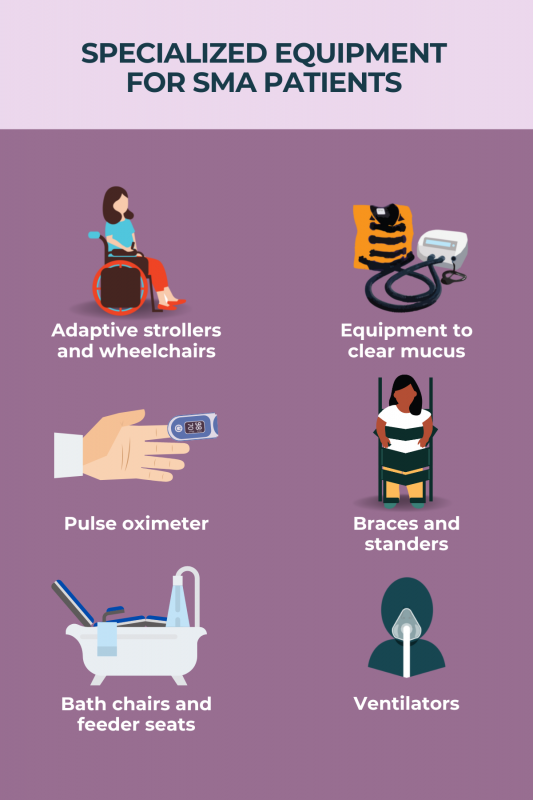Living with spinal muscular atrophy
Spinal muscular atrophy (SMA) is a genetic condition that causes progressive muscle weakness and wasting. Although living with SMA can pose many challenges in day-to-day life, proper medical treatment and the use of adaptive equipment and supportive services, as well as maintaining a healthy lifestyle through diet and exercise, can help individuals with the disorder to maximize their quality of life.
How does SMA type affect daily living?
Historically, spinal muscular atrophy has been classified into types based on a person’s genetics and how the disease manifests:
- Type 0 SMA begins in the womb. It is almost always fatal in the first months of life if untreated.
- Type 1 SMA manifests within the first few months of life. Without treatment, babies with this SMA type are unable to lift their heads or sit unsupported; they typically lose the ability to breathe independently and will usually die by age 2.
- Type 2 SMA begins in young children between 6 and 18 months of age. If untreated, children cannot stand or walk without support, and lifespan is reduced.
- Type 3 SMA starts in childhood. Children with this type usually can walk by the time symptoms appear, but if untreated they may lose this ability as the disease progresses.
- Type 4 SMA manifests during adulthood. Patients may experience muscle weakness and a reduced ability to walk as the disease progresses.
New treatments have dramatically changed outcomes and life quality for many people with SMA. Thus, in the modern age, the experience of people with even severe types of SMA is likely to be very different from how it has been for patients historically.
SMA treatment options
The first disease-modifying therapy for SMA became widely available in 2016, with additional treatments approved in subsequent years. While the specific mechanisms vary, all of the approved SMA treatments broadly work to boost production of the SMN protein whose deficit causes the disease.
Three SMA treatments have been approved in the U.S.:
- Spinraza (nusinersen): The first ever SMA treatment approved, it is indicated to treat all types of the disease. It’s administered via injection into the spine — called an intrathecal injection — every four months.
- Evrysdi (risdiplam): A once-daily therapy, it is approved to treat patients ages 2 months and older with all types of SMA. The treatment can be given orally or via a feeding tube.
- Zolgensma (onasemnogene abeparvovec-xioi): This is a one-time gene therapy authorized in the U.S. to treat children with all SMA types, ages 2 years and younger.
All of these therapies can improve the survival of motor neurons, the nerve cells controlling voluntary movement that gradually die off in SMA. However, these medications cannot revive motor neurons that have already died. For this reason, outcomes from treatment are highly dependent on when they are started — in almost all cases, initiating treatment as early as possible tends to lead to the best clinical outcomes.
Babies who are started on treatment within the first weeks of life, before they show disease symptoms, may have largely normal motor development, reaching milestones like crawling and walking within typical timeframes. Such positive outcomes have been seen even among children expected to develop type 1 disease — who previously, without treatment, would not have been expected to ever be able to sit up independently.
Other children with SMA who start on treatment early in life may continue to develop and hit motor milestones, though development may be slower than what is typical. Some children may not ever hit milestones like being able to walk, even with treatment.
In adults with SMA, available therapies, if initiated, can generally help to stabilize motor function and prevent progressive decline. Typically, however, improvements in motor function are modest, if they occur at all. Therapy outcomes vary depending on how advanced the disease was when treatment started, as well as on other factors affecting individualized responses to treatment, which remain incompletely understood.
Specialized equipment
Using specialized equipment in one’s daily routine can help make day-to-day life with SMA easier and help improve health outcomes. Types of adaptive equipment that are commonly used by SMA patients include:
- adaptive strollers and wheelchairs: For young children with SMA, adaptive strollers can help them sit more comfortably. They also are typically lighter and more portable than wheelchairs, and can be easily loaded in and out of a vehicle, proving helpful for parents and caregivers. For older patients, wheelchairs (either manual or powered) can be helpful for getting around independently. Children as young as 18 months may learn how to use power chairs.
- bath chairs and feeder seats: Specialized chairs can be used to make bathing and eating easier for patients with limited mobility. These usually are designed to minimize repositioning and the number of transfers needed.
- braces and standers: These devices provide structural support to the body. They can be helpful for strengthening muscles and preventing or managing skeletal abnormalities like scoliosis, an abnormal curvature of the spine common in SMA.
- a BiPAP or bi-level positive pressure machine: Worn as a mask over the nose and mouth, or as a tube to the nose, a BiPAP machine is a noninvasive ventilation breathing support. It can make it easier for an SMA patient to breathe by changing the pressure of air during inhalation and exhalation.
- cough assist machines: Weakness of the chest muscles can make it difficult to clear mucus and other secretions in the respiratory tract. A cough assist machine can help ensure the airways stay clear.
- pulse oximeter: Monitoring oxygen levels can be helpful for guiding care and detecting problems in patients with breathing difficulties. A pulse oximeter measures oxygen levels in the blood using a small device attached to a finger or toe.
- high-frequency chest wall oscillation (HFCWO): These systems use an inflatable vest attached to a machine to deliver vibrations to the chest, which can help clear the lungs. An HFCWO is particularly useful for patients with excessive mucus.
- ventilators: Individuals with breathing difficulties may benefit from invasive mechanical ventilators, which help move air in and out of the lungs, for assisted breathing.

Physical therapy and exercise
Getting regular exercise is crucial for maintaining the health of muscles. For SMA patients, exercise can help improve motor function, boost flexibility and range of motion, help maintain posture and prevent contractures, and reduce stress. For most individuals with the genetic condition, exercise is key to maintaining quality of life.
It is generally recommended people with SMA should consult with a specialist, such as a physical therapist, to together design an exercise regime that makes sense from both a patient and caregiver perspective. Experts often recommend patients work to incorporate physical activity into their daily routine, finding playful and fun ways to exercise. It also is important to ensure exercises can be done safely.
Many different types of exercise may be recommended for people with SMA. Specialized exercise equipment like modified swings and adaptive bicycles may be useful for patients with limited mobility. Types of exercise and physical therapy commonly helpful for people with SMA include:
- aerobics, or exercises that get the heart rate up: Aerobics can help to maintain cardiovascular and respiratory health. Examples include walking, swimming, dancing, boxing, rowing, and cycling, to include modified forms of cycling like arm cycling, which is done with the arms instead of the legs.
- resistance training, which involves having to push against a force: Lifting weights is an example, where the force being pushed against is gravity. Other examples include resistance bands or weight machines. These exercises can help build and preserve muscle strength and endurance.
- water therapies: As the name suggests, these are exercises done in water, typically a swimming pool, usually under the guidance of a physical therapist. Being in water can support the body and reduce pressure on the joints, allowing patients to move more easily with a greater range of mobility.
- stretching exercises such as yoga: When regularly and properly done, stretching can help maintain flexibility and reduce joint stiffness and muscle contractions. Stretching can include active range of motion exercises — when a person moves his or her own body — or passive range of motion exercises, when movements are done by applying an external force. Passive range of motion usually involves a therapist pushing or pulling the body.
- activities that require a person to sit upright, such as horseback riding or wheelchair games: Such activities can help to strengthen muscles in the torso and core. These exercises can be helpful for maintaining posture and reducing issues like scoliosis.
- breathing exercises: These interventions work to strengthen the muscles that push air in and out of the lungs when a person breathes, and are generally administered by a specialist. In young children, activities like blowing bubbles can be an easy and engaging way to participate in routine breathing exercise.
Diet
There hasn’t been much formal research on diet in SMA to date, and no one eating plan works for everyone with the disease. The general goal of diet for someone with SMA is pretty much the same as for anyone: eating enough healthy foods to give the body the energy and nutrients it needs.
It is generally recommended people with SMA consult with a nutritionist or other dietary specialist to figure out a diet that works for them. As in the general population, it is typically suggested people with SMA eat lots of fruits and vegetables, whole grains, and lean proteins, while limiting foods that are sugary or processed.
Fasting and weight gain
People with SMA often haver lower-than-normal muscle reserves, which means fasting or going a long time without food can have more pronounced negative health effects. This is especially true if a person is already sick. It is therefore recommended fasting be avoided, especially during illness. In the absence of other health problems, babies with SMA ages 1 or older usually do not need to be woken up at night to feed.
For SMA patients who have limited mobility, it may be easy to gain excess weight because the body is not burning as much energy moving around — and, at the same time, it can be hard to do energy-intensive exercises to lose excess weight. As such, it is recommended patients work to optimize their energy intake to ensure they’re getting all the calories they need, but not excessively more than their body will use. Initiation of disease-modifying treatments also may change caloric needs.
Chewing and swallowing
SMA can cause weakness in the muscles of the jaw and throat, which may make it harder to chew and swallow food. Eating soft, easy-to-chew foods, or consuming foods in forms that are easy to swallow — like purees and smoothies — may make it easier for patients to get all the nutrients they need.
For patients whose ability to swallow is very limited, or for babies with problems sucking, a feeding tube may be used to ensure the patient can get adequate nutrition.
Gastroesophageal reflux disease and low-fat diet
Gastroesophageal reflux disease, or GERD, is a chronic condition in which stomach acid flows back into the esophagus, which is the tube that carries food from the mouth to the stomach. It often results in a sensation of heartburn.
GERD commonly affects people with SMA, particularly those with type 1 disease. Eating a low-fat diet — and especially avoiding fried or greasy foods — can help to reduce GERD symptoms. Cutting out acidic foods like citrus or tomato sauce also may help calm symptoms in some patients. However, because everyone, and especially young children, need a certain amount of fat in their diet, it is advised patients or their caregivers talk to an expert if they are considering switching to a low-fat diet.
Travel
Traveling can be intimidating for people with SMA and their families. Planning well in advance — and taking advantage of adaptive equipment and supportive services — can help make traveling with SMA less of a challenge.
For babies with breathing problems, using a car bed is safer than using an infant car seat. Many families affected by SMA will get a vehicle that has accommodations to allow for wheelchairs and other adaptive devices.
Some older people with SMA are able to drive themselves, though they may require modified vehicles adapted to suit their needs.
When traveling by other methods, such as plane, bus, or train, accommodations and policies are often variable, and special considerations may be needed for wheelchairs and other adaptive equipment. Many airlines and other travel services have specific policies in place to help people who have special needs. It is suggested patients discuss their needs and make plans well in advance, which can help ensure everything goes as smoothly as possible at the time of travel.
Life expectancy and palliative care
Without treatment, babies born with SMA types 1 or 0 usually do not survive infancy. Those with type 2 disease may survive into adulthood without treatment but usually have a shorter-than-normal lifespan, while life expectancy is generally unaffected in the less severe SMA types 3 and 4.
The introduction of new treatments within the last decade has completely transformed SMA life expectancy outcomes.
For example, babies with type 1 who start on early treatment can survive years into childhood, and may even have typical motor development. Because these treatments have only become available in recent years, it is not known how they will affect life expectancy for SMA patients in the long-term — right now, babies treated in the earliest clinical trials are around elementary school age.
Palliative care is a branch of medicine that aims to maximize patients’ comfort and improve quality of life for the individual and his or her family. Although palliative care sometimes includes planning for the end of life, it’s not the same thing as end-of-life or hospice care. Palliative therapy may offer benefits for patients in all stages of disease, and it is generally recommended people living with SMA receive multidisciplinary palliative care to help ensure their medical, social, and spiritual needs are being met.
SMA News Today is strictly a news and information website about the disease. It does not provide medical advice, diagnosis, or treatment. This content is not intended to be a substitute for professional medical advice, diagnosis, or treatment. Always seek the advice of your physician or other qualified health provider with any questions you may have regarding a medical condition. Never disregard professional medical advice or delay in seeking it because of something you have read on this website.
FAQs about living with SMA
Each person has two copies of the SMN1 gene that causes spinal muscular atrophy (SMA) — one inherited from each biological parent. SMA will only develop if both copies are mutated. People with SMA are guaranteed to pass on one mutated copy of the gene to their biological children, who will only develop the disease if they also inherit a second mutated copy from their other parent.
Some health insurance plans may provide coverage for specialized equipment, while others won’t, depending on the company’s policies. It is suggested that spinal muscular atrophy patients or their caregivers talk to their healthcare team and insurance providers about accessing specialized equipment.
Muscle weakness that results from spinal muscular atrophy (SMA) can make operating a motor vehicle difficult, but many patients are able to drive. Vehicle modifications can make driving easier for people with SMA.
Spinal muscular atrophy (SMA) is a progressive disease, which means that the symptoms generally worsen over time. However, in recent years, a number of disease-modifying treatments have become widely available; these can slow or even stop the progression of SMA. The use of specialized equipment also can help to better manage SMA symptoms.
Historically, most people born with spinal muscular atrophy (SMA) have had a markedly shortened lifespan. However, new disease-modifying treatments can allow patients — especially infants — to live longer than has ever been possible before. Because these treatments were developed only recently, the long-term SMA life expectancy for someone being treated is currently impossible to know with certainty.
Related Articles

 Fact-checked by
Fact-checked by 







